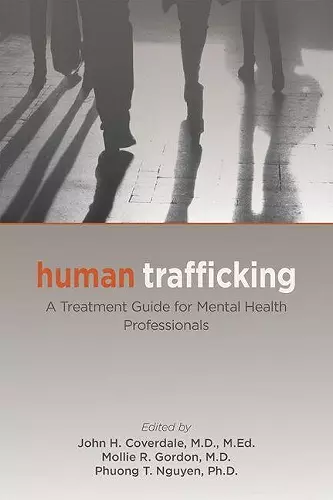Human Trafficking
A Treatment Guide for Mental Health Professionals
John H Coverdale editor Mollie R Gordon editor Phuong T Nguyen editor
Format:Paperback
Publisher:American Psychiatric Association Publishing
Published:10th Aug '20
Currently unavailable, and unfortunately no date known when it will be back

Human Trafficking: A Treatment Guide for Mental Health Professionals is the first book on human trafficking and mental health. The editors have marshalled their considerable experience developing resources and interventional programs for this patient population, as well as expertise in research and scholarly writing, to create a unique—and uniquely useful—guide for clinicians likely to encounter trafficked patients. Foundational to the effort is recognizing that their numbers are legion, and growing, and that their safety and well-being depends on the ability of clinicians to screen, assess, and identify them in a system that often constructs barriers to care. Epidemiological data is provided to help clinicians understand the factors that contribute to being trafficked, the associated consequences, and the role of health professionals in combatting it. Screening processes are discussed, and potential barriers, both organizational and provider-based, to the identification of trafficked persons are explored. The next section addresses sensitive, trauma-informed, and integrated patient management in different settings, including emergency departments, primary care, and substance abuse facilities, since both medical and substance abuse comorbidities are common in trafficked patients. The trauma-informed concepts of asking, respecting, and responding are vital components to the survivor-centered care emphasized by the authors, and psychotherapeutic considerations and cultural aspects in the assessment and treatment of these patients—topics that have been neglected heretofore—are discussed in-depth. Finally, advocacy, confidentiality, and reporting requirements for adult and child patients are addressed, providing a much-needed legal and ethical framework.
The chapters have clearly outlined objectives that are achieved through a number of useful features:
• Each chapter includes clinical cases that encapsulate the trauma and horror of the real-life fallout from human trafficking. These vignettes deftly illustrate and contextualize the chapter's topic, such as managing co-occurring substance use disorders or identifying the trafficked person who presents in the emergency department.
• Chapters are equipped with "pearls and pointers" that summarize key points and highlight the most important take-aways.
• Contributors make ample use of visual aids, such as tables and figures, that enhance understanding and consolidate information into readily accessible formats.
• Ten vivid, real-life case scenarios are offered in the final chapter, providing the clinicians with insights into trafficked persons' health care interactions, questions to increase sensitivity and help identify these patients,...
The International Labour Organization reported
that, in 2016, 24.9 million people were trafficked,
20.1 million as forced labor and 4.8 million for
commercial sex. These numbers are probably an
underestimate but they indicate that human trafficking is a huge problem that psychiatry has
neglected. The editors of Human Trafficking: A
Treatment Guide for Mental Health Professionals
have put together a very experienced group of
authors who provide a rich and comprehensive
review of this human tragedy. In their preface, the
editors state that their goal was to create "an
educational and clinical resource for mental health
practitioners as well as clinicians from any discipline who might encounter trafficked persons
(which is essentially all of us in the health care
field)." The 25 authors include international
experts in multiple disciplines, 14 of whom are
physicians. Each chapter is concisely written and
includes diagrams and charts as well as "Pearls
and Pointers" at the end to emphasize the main
points. As the editors' goal was to create a reference source, each chapter also includes an extensive bibliography.
For clinicians, I single out some particularly
helpful information. There is an excellent
description of signs and symptoms that may present in a trafficked person in the emergency
department. The discussion of comorbid medical
conditions covers sexually transmitted diseases
and the need to coordinate interventions for both
physical and mental health. Trafficked individuals
face many difficulties accessing medical care,
including especially being able to pay, language
barriers, safety concerns, and chronic illnesses
that require long-term care that is not usually
available to someone who is trafficked. Special
chapters deal with sexual abuse and child trafficking for labor and sex. Since many trafficked
persons in the United States come from foreign
countries, cultural issues and the need for culturally appropriate assessment is very important and
these topics are well covered.
When discussing management, all of the
authors emphasize the need for trauma-informed
care that is characterized by empathy, trustworthiness, and collaboration; however, this stress
on the need for "trauma-informed care" may seem
like an overused platitude. Although there are no
data or evidence to guide treatment, the use of
cognitive-behavioral or exposure therapies to treat
trafficked individuals does not seem to be a good
idea. These patients come from different cultures
and have massive traumas that greatly impair
their ability to process information. Providing
exposure therapy to people who suffer from frequent nightmares and startle reactions seems
almost harmful. For long-term treatment, gentle
consistency and judicious use of medicine in a
supportive relationship seems likely to be the
most helpful method for reducing suffering, even
though firm evidence is lacking.
The last chapter "Survivor Voices" presents
accounts by those who escaped and were able to
recover and write about their traumatic experiences. These are truly inspiring stories by remarkable people who have triumphed. However, I
wonder about the hundreds of others who were not
able to escape, who live out a life of humiliation,
fear, drug addiction, and struggles with depression
and suicidal thoughts.
In summary, this is an excellent book about a
neglected and underreported group. People who are
trafficked have multiple psychiatric and other health
disorders and clearly need medical approaches to
alleviate their suffering.
ISBN: 9781615372485
Dimensions: 229mm x 152mm x 12mm
Weight: 481g
284 pages